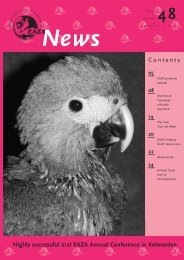EAZA News 58-9 - European Association of Zoos and Aquaria
EAZA News 58-9 - European Association of Zoos and Aquaria
EAZA News 58-9 - European Association of Zoos and Aquaria
Create successful ePaper yourself
Turn your PDF publications into a flip-book with our unique Google optimized e-Paper software.
Budapest hungary source<br />
ilma bosch<br />
The worlds’ first alive southern white rhino (Ceratotherium simum<br />
simum) conceived through artificial insemination, was born on 23 January<br />
2007. The successful artificial insemination took place on 8 September<br />
2005, after which the pregnancy lasted 16 months <strong>and</strong> 15 days. During<br />
this period the veterinarian team continuously checked the health status<br />
<strong>of</strong> both mother <strong>and</strong> fetus by collecting faecal samples <strong>and</strong> blood in order<br />
to measure hormone levels. Regular ultrasound examinations, via a<br />
4D GE ultrasound device, were carried out as well. On 3 December 2005,<br />
one <strong>of</strong> these examinations revealed a 8,5 cm long fetes.<br />
At birth, the female calf was <strong>58</strong> kg <strong>and</strong> 117 cm long. She stood up an hour<br />
after birth <strong>and</strong> started to search for her mother’s nipple. Unfortunately<br />
her mother ‘Lulu’ did not let her suckle. Sometimes Lulu even showed<br />
aggression towards her baby <strong>and</strong> therefore, after 8,5 hours, the Budapest<br />
Zoo team decided to feed the calf by a colostrum product.<br />
After the reintroduction following this feeding, Lulu viciously attacked<br />
her baby. Consequently, it was decided to continue the h<strong>and</strong>-rearing<br />
process. Fortunately, Lulu is willing to let the keepers <strong>and</strong> vets milk her,<br />
so the baby receives actual rhino milk.<br />
photo béla sz<strong>and</strong>elszky<br />
Newquay united kingdom source<br />
website Newquay Zoo <strong>and</strong> Stewart Muir<br />
A baby western black <strong>and</strong> white colobus monkey (Colobus<br />
polykomos) is being h<strong>and</strong>-reared by staff at Newquay Zoo after the<br />
mother rejected the baby. The baby was born on 30 December 2006 <strong>and</strong><br />
staff kept a close eye on seven-year-old mother ‘Sierra’ as her previous<br />
baby had not survived beyond a week. This time it was decided to not<br />
take any chances <strong>and</strong> staff kept a very close watch on how the female<br />
was treating the baby. It became evident very quickly that this baby was<br />
going to suffer a similar fate if staff did not intervene.<br />
After discussions with keeping staff <strong>and</strong> the EEP coordinator for this<br />
species, it was agreed to remove the baby <strong>and</strong> h<strong>and</strong>-rear with a view to<br />
returning her to the main group as soon as possible. Once the baby was<br />
removed for h<strong>and</strong>-rearing it was identified as a female. Head keeper Sam<br />
Harley, who has much experience in h<strong>and</strong>-rearing animals, quickly got<br />
into the routine <strong>of</strong> feeding every two hours night <strong>and</strong> day. The baby was<br />
named ‘Sokojoo’ which means ‘Hiccup’ (as the baby sometimes hiccups<br />
after she has fed her) in M<strong>and</strong>inka, the language <strong>of</strong> Gambia which is<br />
where these monkeys originate.<br />
As soon as the baby is onto solid food, it will be placed into a small<br />
enclosure next to the main colobus enclosure so that she can get used<br />
to the sights, sounds <strong>and</strong> smells <strong>of</strong> the adult colobus <strong>and</strong> they can get<br />
used to her. The keepers will continue to feed her <strong>and</strong> check on her,<br />
<strong>and</strong> then hopefully within the next few months it will be possible to<br />
reintroduce her to the main group. Newquay Zoo currently has a group<br />
<strong>of</strong> 1.3 colobus, including the most recent <strong>of</strong>fspring. There are some thirty<br />
animals in Europe, kept by six zoos, all participating in the EEP for this<br />
species.<br />
births <strong>and</strong> hatchings<br />
photo newquay zoo<br />
eaza news <strong>58</strong><br />
2007<br />
13

















